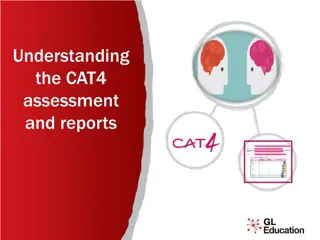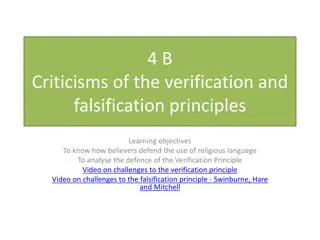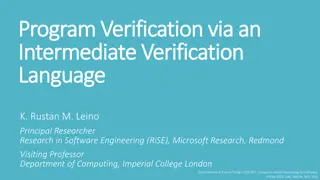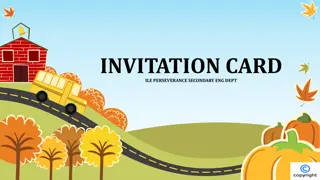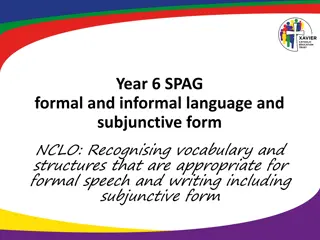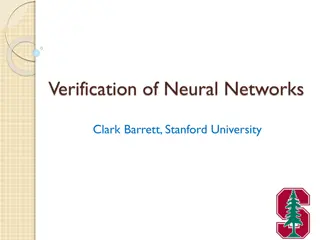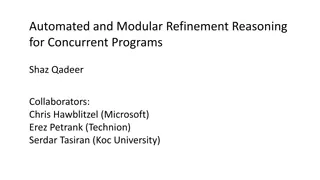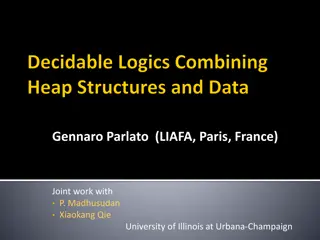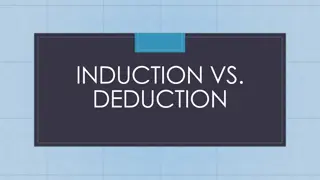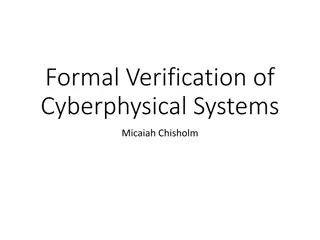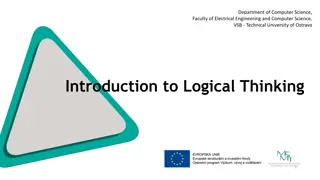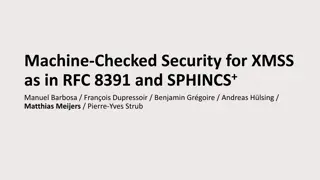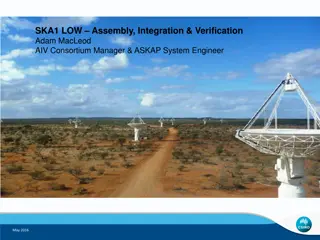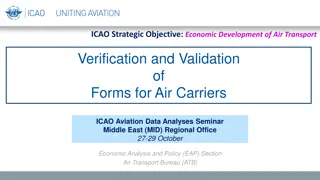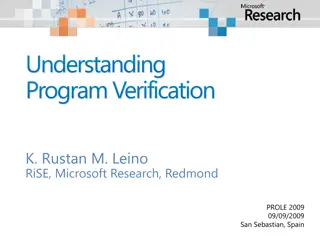Formal Verification and Reasoning in Computer Science
Explore the concepts of formal verification and reasoning in computer programs, processes, and cyber-physical systems. Understand problem definitions, state-based modeling, Kripke structures, and verification questions. Dive into the USC Viterbi School of Engineering's course material for a comprehensive understanding of these key topics.
Download Presentation

Please find below an Image/Link to download the presentation.
The content on the website is provided AS IS for your information and personal use only. It may not be sold, licensed, or shared on other websites without obtaining consent from the author.If you encounter any issues during the download, it is possible that the publisher has removed the file from their server.
You are allowed to download the files provided on this website for personal or commercial use, subject to the condition that they are used lawfully. All files are the property of their respective owners.
The content on the website is provided AS IS for your information and personal use only. It may not be sold, licensed, or shared on other websites without obtaining consent from the author.
E N D
Presentation Transcript
Introduction to Formal Verification/Reasoning Fall 2018: CSCI 699 Instructor: Jyo Deshmukh Course materials: http://www-bcf.usc.edu/~jdeshmuk/teaching/cs699-fm-for-cps/index.html USC Viterbi School of Engineering Department of Computer Science 1
Formal Verification: Problem Definition Let ? be a program (or process or a CPS) Assume that there is a specification ? of good or bad behavior of ? Check that ? ? For all inputs to ? (possibly infinite) OR For all initial configurations for ? : double turnstile, also read as models or satisfies Note in testing, we take some subset of inputs to the program, or some subset of initial configurations and check if ? satisfies ? for just that subset USC Viterbi School of Engineering Department of Computer Science 2
State-based modeling of programs At any point in program execution, its state is everything that constitutes the configuration of the program Program counter, values of all variables, etc. Any program can be viewed as a system that defines a transition system over a set of states TwoBitCounter() initially x0 := 0, x1 := 0 11 10 00 01 always x0,x1 := 1-x0, x0 x1 USC Viterbi School of Engineering Department of Computer Science 3
Kripke structure Useful abstraction for concurrent programs/processes Defined as a structure ? ?,?,? , where: ? is a finite or infinite, nonempty set of states ? is a transition relation that is some subset of ? ? ? is a labeling function from ? to 2??, where ?? is a set of atomic propositions ?, ? ?,? ?,? ?,? ? = 00,01,10,11 ? = 00,00 , 00,01 , 01,10 , 10,01 , 10,11 , 11,00 ? = {00 ?,? ,01 ?,? ,10 ?, ? ,11 ?,? } Initial state ?0= 00 11 10 00 01 USC Viterbi School of Engineering Department of Computer Science 4
Verification question Does the following hold? ?,?0 (if ? is true in a state, in some future or present state ? becomes true) ?, ? ?,? ?,? ?,? 11 10 00 01 USC Viterbi School of Engineering Department of Computer Science 5
Verification question ?,?0 (if ? is true in a state, in some future or present state ? becomes true) Yes! ?, ? ?,? ?,? ?,? 11 10 00 01 States 00, 11 trivially satisfy property State 01, ? is not true, so we can ignore it For State 10, the two next states are 01 and 11, where ? holds, so we are done USC Viterbi School of Engineering Department of Computer Science 6
Verification question ?,?0 (if ? is true in a state, in some future or present state ? becomes true) ?, ? ?,? ?,? ?,? 11 10 00 01 No, because starting from state 10, there is a path where ? never holds: 10 10 10 USC Viterbi School of Engineering Department of Computer Science 7
Key Problems: Specifications and Model Checking Can we express the property of interest in some machine-checkable (and unambiguous form)? Yes, using Temporal Logic, automata, etc. Given a Kripke structure/transition system, can we check if a given property holds for it algorithmically? Yes, using a set of algorithms collectively known as model checking Kripke structure is the model of the program Model is also a term from logic: given a logical formula, a structure demonstrating satisfiability of the formula is called a model We are checking if a given program can be the model for a given logical formula USC Viterbi School of Engineering Department of Computer Science 8
Challenges: State Explosion Consider a simple program that manipulates two unsigned integers (4 bytes each) This program has 232 232 states! Going from a program to a Kripke structure/transition system causes state explosion Even if there are efficient algorithms for checking if a property holds for a given Kripke structure, if the structure is astronomically big, verification becomes intractable! Many complementary ways to ameliorate state-space explosion Symbolic Techniques Abstraction/Refinement USC Viterbi School of Engineering Department of Computer Science 9
Symbolic techniques Main idea: Do not construct Kripke structure for program explicitly, but develop a symbolic representation for the transition system corresponding to the program In Boolean programs (hardware verification): with the use of Binary Decision Diagrams and propositional SAT In software programs: with the use of constraint solvers and SAT modulo theories (SMT solvers) Symbolic model checking algorithms then perform verification with the help of constraint solving/SAT We will learn the details in some of the papers we explore USC Viterbi School of Engineering Department of Computer Science 10
Abstraction/Refinement Main idea: Remove some detail from the program to create an abstraction of the program Abstract program is typically much smaller than the actual program, and is an over-approximation: the abstract program will contain strictly more behaviors than the concrete program (because some detail was removed) Run analysis algorithms on the smaller abstract program If the abstract program satisfies the spec, we are done (if less detailed behaviors satisfy the spec, more detailed behaviors will also satisfy it). If abstract program does not satisfy the spec, it may be a false positive: we then use refinement to improve the quality of abstraction USC Viterbi School of Engineering Department of Computer Science 11
Example of abstraction int x = 1000; while (x > 0) do x := x-1; od halt Concrete state Abstract state 1000 999 Abstract transition 2 1 x=0 x>0 Property to prove: always x 0 observe that abstraction is conservative (every behavior in actual program is a behavior in the abstraction) above abstraction is sufficient to prove that the property holds! USC Viterbi School of Engineering Department of Computer Science 12
Need for refinement Concrete state for y int x = 1000; int y = 0; while (x > 0) do x,y := x-1, (y+1) mod 2; od halt Concrete state for x Abstract state , , 0 1000 1000 1 Abstract transition , , 0 0 1 0 , , 0 1 1 1 x>0 x=0 Property to prove: (x mod 2)=(y mod 2) observe that above abstraction is not good as it contains states where (x mod 2) (y mod 2) USC Viterbi School of Engineering Department of Computer Science 13
Refinement example int x = 1000; while (x > 0) do x := x-1; od halt x>0 x%2=0,y=0 x%2=1,y=1 Concrete state 1000 999 Old Abstract state New Abstract state 998 997 0 2 1 Old Abstract transition x=0,y=0 Property to prove: (x mod 2)=(y mod 2) refine or split state into two new states, and add transitions between new states and surviving old states Abstraction is now rich enough to prove required property USC Viterbi School of Engineering Department of Computer Science 14
Refinement fails int x = 1000; while (x > 0) do x := x-1; od halt Concrete state 1000 499 Old Abstract state New Abstract state 999 498 500 1 Old Abstract transition New abstract transition x>=500 500>x>0 x=0 x>0 Property to prove: if x>=500 , then eventually x<500 refine or split state into two new states, and add transitions between new states and surviving old states Abstraction still not rich enough, need a ranking function to show that the system eventually exits state x>=500 USC Viterbi School of Engineering Department of Computer Science 15
General challenges for abstraction/refinement How do you compute program abstractions automatically? How do you do the abstraction-refinement process efficiently? Many types of abstractions explored in the community Predicate Abstraction (use specific Boolean predicates to abstract the program) Partial order reduction for concurrent programs (remove interleaved executions that do not have bearing on the property) Symmetry reduction (exploit system symmetry) Using abstract interpretation: interpret program as a transformer over some abstract domains (e.g. intervals, signed vs. unsigned sets, etc.), and use SMT solvers CounterExample Guided Abstraction Refinement (CEGAR) by Clarke et al is a popular technique used for automating abstraction refinement process USC Viterbi School of Engineering Department of Computer Science 16
CPS modeling Model-Based Development (MBD) popular paradigm for developing software, typically uses three kinds of models: 1. Plant Model: Encapsulates physical processes to be controlled/regulated/ monitored by software May be modeled using differential or algebraic equations Typically models continuous-time evolution of continuous-valued physical quantities 2. Environment Model: Captures anything that cannot be controlled and is external to the system 3. Controller Model: Encapsulates the software component that continuously senses the plant and the environment and reacts to it USC Viterbi School of Engineering Department of Computer Science 17
Typical closed-loop model Plant Model Environment Controller System Dynamics Actuators Sensors USC Viterbi School of Engineering Department of Computer Science 18
Typical closed-loop model: issues in FV Typically Stateful, Continuously evolving component with limited visibility of state, and possible stochasticity Plant Model Environment Controller System Dynamics Actuators Sensors Stochastic or Nondeterministic assumptions on real-valued, real- time quantities Stateful or Stateless Reactive, Real- Time Software Program USC Viterbi School of Engineering Department of Computer Science 19
Case studies for verification Catalytic converters reduce HC, CO2, and NOx emissions efficiency optimally when A/F ratio is at stoichiometric value Objective: Control A/F to within 5% of nominal value How do we model? Plant: models internal air and fuel delivery dynamics Controller: Proportional + Integral controller to regulate A/F ratio Environment: Driver requests for torque USC Viterbi School of Engineering Department of Computer Science 20
Controller: Modeled as a Hybrid Automaton startup ?ref= 14.7 Startup Time ?? No Feedback Control Only feedforward estimator Feedback Control + Feedforward estimator normal ?ref= 14.7 ???: Throttle angle, i.e. environment input from driver ??? ??? ??? ??? sensor failure power ??? ?????= ??.? ?ref= 14.7 USC Viterbi School of Engineering Department of Computer Science 21
Plant: Modeled as Differential Equations ?? ??= 10(??? ?) ?,?,??,??,?? : States of the continuous program aka plant model ?in,?: Inputs to the plant model 2 ?12(?2+ ?3?? + ?4??2+?1?2? ?? ??= ?1 2 ? ? ? ?10 ?10 ?2 ? ??2= 0.002 0.12? ? 1 ?? ?? + ?? (??,?) ?? ? + ??= 1 ? ?,?? ?(?,??) Differential equations describe the transition relation of this system ??? ??= ? ?,?? ?? ? ?(?,??) USC Viterbi School of Engineering Department of Computer Science 22
Verification challenge for closed-loop CPS models State variables are real-valued: set of states may not be countable! Models do not evolve in discrete time-steps: evolve continuously in time Transitions are thus not finite in number or discrete in length, but continuous Properties of interest in CPSs may involve real-time specifications (e.g. the A/F ratio is within 10% of reference within 2 seconds) CPSs typically have an uncertain environment (e.g. user may nondeterministically change throttle angle), and we may also use stochastic assumptions (e.g. user alternating between wide-open throttle and fully closed throttle may be statistically less likely) USC Viterbi School of Engineering Department of Computer Science 23
Some concepts you may need through this course Some terms that may appear in papers: Reachability analysis, Bisimulation/Simulation Relations, Equivalence relations, Quotient structures, Product construction, Emptiness checking, Language equivalence, Undecidability, Under/Over-Approximations, ODEs, Initial Value Problem, Numerical solutions to ODEs, etc. May be good to review these terms (independently or see me in office hours) Think of this as a course that will connect the worlds of software verification and CPS verification: we will borrow techniques from either world to improve the state-of-the-art in the other world USC Viterbi School of Engineering Department of Computer Science 24
Bibliography Clarke, Edmund, Orna Grumberg, Somesh Jha, Yuan Lu, and Helmut Veith. "Counterexample-guided abstraction refinement for symbolic model checking." Journal of the ACM (JACM) 50, no. 5 (2003): 752-794. Huth, Michael, and Mark Ryan. Logic in Computer Science: Modelling and reasoning about systems. Cambridge university press, 2004. Peled, Doron. "Ten years of partial order reduction." In International Conference on Computer Aided Verification, pp. 17-28. Springer, Berlin, Heidelberg, 1998. Emerson, E. Allen, and Richard J. Trefler. "From asymmetry to full symmetry: New techniques for symmetry reduction in model checking." In Advanced Research Working Conference on Correct Hardware Design and Verification Methods, pp. 142-157. Springer, Berlin, Heidelberg, 1999. Ball, Thomas, Rupak Majumdar, Todd Millstein, and Sriram K. Rajamani. "Automatic predicate abstraction of C programs." In ACM SIGPLAN Notices, vol. 36, no. 5, pp. 203-213. ACM, 2001. Graf, Susanne, and Hassen Sa di. "Construction of abstract state graphs with PVS." In International Conference on Computer Aided Verification, pp. 72-83. Springer, Berlin, Heidelberg, 1997. Cousot, Patrick, and Radhia Cousot. "Abstract interpretation: a unified lattice model for static analysis of programs by construction or approximation of fixpoints." In Proceedings of the 4th ACM SIGACT-SIGPLAN symposium on Principles of programming languages, pp. 238-252. ACM, 1977. USC Viterbi School of Engineering Department of Computer Science 25







